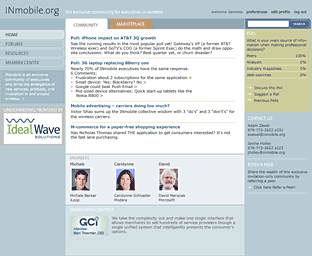 To succeed, professionals need to collaborate. It’s always been this way — especially for professional services practitioners. The rise of the consulting firm — groups of professionals in the same place, groups of subject matter experts working for the same firm in many different places — has been driven, in part, by the necessity for collaboration.
To succeed, professionals need to collaborate. It’s always been this way — especially for professional services practitioners. The rise of the consulting firm — groups of professionals in the same place, groups of subject matter experts working for the same firm in many different places — has been driven, in part, by the necessity for collaboration.
Many types of professionals — think lawyers and doctors — have functioned this way. Historically, their network of peers tended to be those in closest proximity: in the same office, the same firm or institution, or in the same region. This face-to-face setting offers key benefits, such as a good, old-fashioned handshake to deepen trust and foster the spirit of collaboration. However, today’s consultants often end up with professional marriages-of-convenience with peer advisors, as opposed to seeking out the best person with the best information to help them.
It’s ironic that the demands of the job often prevent effective collaboration and knowledge-sharing. When people are very busy — and today’s time-strapped, multi-tasking consultants certainly qualify — they are least likely to ask for help. Long hours, time away from the office, significant travel and deadline-driven work pressures all tend to get in the way of a professionals’ ability to exchange the right information with the right person at the specific point of need.
In-person networks or peers will never go away, but they are being augmented with a new breed of knowledge exchange to better support professional collaboration. The in-person-only strategy no longer works. The use of virtual collaboration and knowledge-sharing tools is becoming the new normal.
Some professionals have a bias against these knowledge networks due to past experience. Those intranets of yesteryear — difficult software solutions requiring document uploads at the end of every month, never to be seen again — evoke bad memories. The collaboration model today is different, closer to the social networks found in our personal lives. This ease of use, coupled with a growing need for faster and more efficient collaboration, creates a perfect case for integrating knowledge networks into professional best practice.
Recently, my colleagues over at Bloom Group wrote a fantastic piece on why consulting companies need social media to market their ideas more effectively. While ringing true, I would add to this the idea that consulting firms would also benefit from using social tools such as internal communities and knowledge networks to enhance collaboration.
Successful knowledge networks are about supporting existing human business processes online and eliminating in-person system flaws. To succeed, a knowledge network has to solve a real business problem or make a business process easier by using the online channel.
For example, finding and connecting with a subject matter expert can be a challenge in a time-dependent situation. How do you manage your list of go-to resources? Chances are, it is manual process. However, internal online communities and knowledge networks give access to the right subject matter expert needed for the most up-to-date information — far faster and more effectively than doing a walk-around.
Once in use, an effective knowledge network supports a more agile and productive work stream inside the organization, not to mention helping the practice respond more quickly to ever-changing needs.
Building and supporting a knowledge network is not something you can just unwrap and plug in. The processes for creating and supporting knowledge networks need to be approached in a step-by-step fashion, and carefully considered from both social and technical perspectives.
Here are 10 critical success factors to creating a useful and vibrant knowledge network:
- Tie KPIs to outcomes. Define the business goals the network should support: e.g. better decision-making when talking to other professionals; reducing questions for outside help resulting in cost savings.
- Invest in research about user needs. To create the right information ecosystem, you need to know what kinds of information your users need most often. Ask them.
- Leadership support is essential. Be sure senior executives will advocate and use the network. Lip service from the C-level does not an effective knowledge network make.
- Launch with beta projects. Learn from early experience and evolve the network to grow your institutional best practices.
- Train and educate consultants on using the network. Actively mange, encourage and create incentives for their participation
- Limit content. Focus on search best practices to help users zero in on most-needed information.
- Build it for users. Ensure the system is secure, useful, usable and engaging.
- Integrate the network into the larger organization. Provide support for the internal client base and help them adapt.
- Manage the risk. Emphasize confidentiality, privilege and privacy to keep information secure and encourage the free flow of ideas internally.
- Measure what really matters. Focus on outcomes and ROI, not just what easy to measure.
Warning: Attempt to read property "base" on array in /home3/trusten9/public_html/leadernetworks/wp-content/plugins/wp-user-profile-avatar/shortcodes/wp-user-profile-avatar-shortcodes.php on line 665
Warning: Attempt to read property "base" on array in /home3/trusten9/public_html/leadernetworks/wp-content/plugins/wp-user-profile-avatar/shortcodes/wp-user-profile-avatar-shortcodes.php on line 665
Warning: Attempt to read property "base" on array in /home3/trusten9/public_html/leadernetworks/wp-content/plugins/wp-user-profile-avatar/shortcodes/wp-user-profile-avatar-shortcodes.php on line 665
Warning: Attempt to read property "base" on array in /home3/trusten9/public_html/leadernetworks/wp-content/plugins/wp-user-profile-avatar/shortcodes/wp-user-profile-avatar-shortcodes.php on line 665
Related Posts
March 8, 2018
Why KM is Your Super Power
Remember back in January when I predicted that, in 2018, more and more…
March 18, 2010
Designing Web-Based Communities for Professionals
Designing online communities for business is a subtle blend of creating the…


